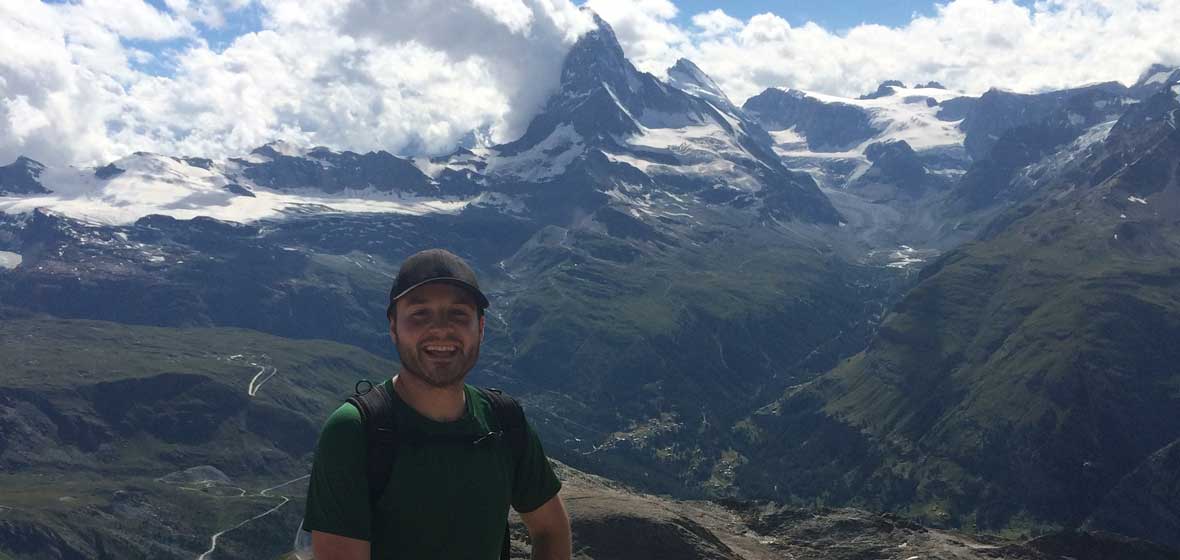Nearly a year into his master's degree program in electrical engineering, Guillermo Aramendia was encountering some serious technical challenges.
His research project involved the computational electromagnetic study of the effect of high-intensity nano pulses on bovine chromaffin cells, which are a well- known model of neurons. But in attempting to construct an accurate three-dimensional model of the cell, Aramendia ran into some challenges with the electromagnetic software he was using.
That's when Aramendia received some good news - he'd received a prestigious scholarship from the Swiss government to do research in Zurich over the summer. The scholarship, ThinkSwiss, connects student researchers at U.S. and Canadian universities with researchers in Switzerland. And thanks to his advisor, Indira Chatterjee, Aramendia was accepted to work with Professor Niels Kuster's group at the Foundation for Research and Information Technologies (IT'IS) that had developed the electromagnetic software that he was using for the cell modeling. While in Zurich, Aramendia worked with Dr. Esra Neufeld, a researcher at IT'IS.
Aramendia was able to test a version of the software, Sim4Life, which is not yet available to researchers. While Aramendia used that software to build his 3D cell model, he noted bugs in the program and provided suggestions for Neufeld's team of software developers.
"The main challenge in my project was to properly model in detail all the parts of the cell; there were many attempts with 2-D models and a very limited 3-D model. With this new branch of Sim4Life, I now have the ability to create a more realistic model of the cell," Aramendia said. "It was a win-win. I was able to make progress on my master's thesis, and IT'IS was getting feedback on the program."
{{RelatedPrograms}}
Now, back on campus with a functional cell model created, Aramendia is working on modeling the electromagnetic behavior of the cells when exposed to high-intensity nano pulses. He plans to run some additional simulations and hopes to defend his master's degree thesis in December.
The computer model of the chromaffin cell will help corroborate experiments that are being performed in the laboratory of Pharmacology Professor Gale Craviso, who has been collaborating for over 20 years with Chatterjee, a professor of electrical and biomedical engineering.
"The experience in Switzerland was very rewarding for Guillermo," Chatterjee said. "He gained exposure to state-of-the-art facilities at IT'IS and an opportunity to not only make progress on his master's thesis but also to interact with very experienced engineers working in the field.
Engineering exchange program led Aramendia to University of Nevada, Reno
Zurich wasn't Aramendia's first experience studying abroad. In fact, he first came to the University of Nevada, Reno as an undergraduate exchange student from San Sebastian, Spain in 2013. Aramendia spent a semester here studying electrical engineering as part of an engineering exchange program between the College of Engineering and Tecnun School of Engineering in Spain.
When Aramendia graduated from Tecnun and decided to pursue a master's degree, he returned to the University to work with Chatterjee. Aramendia started his master's degree in the fall of 2014,working as a graduate teaching assistant for the freshman engineering course Engineering 100.
"The program of study at the University of Nevada, Reno was more diverse and furthermore the University gave me the excellent opportunity to be a graduate teaching assistant," Aramendia said. "All this, combined with living in Reno, aided my fluency in English, an essential skill in the modern world of research and engineering."
Aramendia plans to pursue a Ph.D. after graduation, continuing this research with more complex cell models.












